I just returned from a trip to Colorado through northern New Mexico. This was nothing new; I’ve been that way before and have fallen in love with that part of the state. There is an ageless beauty to the landscape and a gracious spirit among the people living in the small towns and villages. Some families go back 400 years in the same community. New Mexico is the fifth largest state – bigger than Illinois and New York combined – but has only two million residents, mostly living in or around the Santa Fe – Albuquerque area. That means that the rest of the state is sparsely populated and change comes slowly – when it comes.
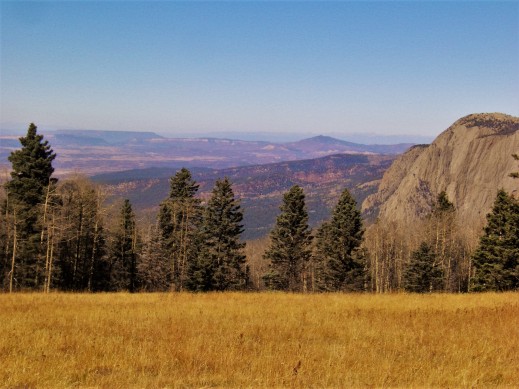
I was not on a tight schedule during my recent trip so I wandered a bit. That just whetted my appetite to see what is up in the next valley or around the bend. I will have to go back to explore some of those places on another trip…or two…or three.
Many of the old villages were somewhat isolated until well into the 20th century. If you look at a detailed map you will see a few main highways that kept mostly to the valleys but there are smaller roads connecting these communities. Then there are tracks leading around and through the named communities and off in various directions from the villages and towns to homes or fields. There were no city planners back in the 17th century and the villages were somewhat dispersed based on the availability of water and farm land and the various land grants from the King of Spain. These do not resemble towns or villages of the Midwest or New England. Many are unincorporated and exist as census designated places. Many of these smaller communities will have an ancient “acequia madre” that irrigates the local farms and kitchen gardens through a series of smaller water channels. Some of the larger places might have a Family Dollar Store and there might be a post office. Almost all will have a parish church of some type.
The parish church is a central focus point for many of these communities going back into the 1700s. I found myself taking pictures of these adobe churches on this and earlier trips. These are just a few…there are dozens more.
San Francisco de Asis
Thanks to Ansel Adams, the most famous and most frequently photographed church in the region is San Francisco de Asis in Ranchos de Taos, dating to the 1770s and reaching its current configuration around 1816. This was a mission church built by the Franciscans in what was then a fortified plaza. Ansel’s iconic photographs are in black and white but there is a lot of color there. The building has something of a glow due to reflected light and, although just a mass of mud and straw, it takes on some interesting colors. The building itself is not pink but there is sometimes a reddish or even lavender cast to the adobe mud surface depending on the light. The massive walls and buttresses present different shapes and surfaces that reflect light differently throughout the day.
The interior of the church is off limits to photography but there are photos on the internet of the interior and the two altar pieces. It is fairly simple in terms of decoration, which is typical for these old mission churches.
Thanks to Ansel Adams, there were about a dozen people all taking pictures of the place when I was there. On my first visit, about five years ago, the church was being re-mudded with a fresh coat of mud and straw plaster. That seemed to be a community project.
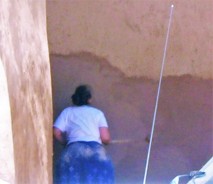
Santa Cruz – Holy Cross
 Spanish settlers began occupying the Espanola valley around 1595 in small villages and scattered haciendas. These early settlers were driven out in 1680 during the Pueblo Revolt but returned after the re-conquest about a dozen years later. A few years later the Spanish Governor saw a need to establish authority and protect settlers in the area north of Santa Fe and established a new administrative town, called a “villa”, in 1695. The town was named Villa Nueva de Santa Cruz de los Españoles Mejicanos del Rey Nuestro Señor Carlos Segundo (The New Town of the Holy Cross of Mexican Spaniards under the King Our Lord Charles II). That was a mouthful in any language so it was eventually shortened to Santa Cruz de la Cañada. “La cañada” is a descriptive term meaning sloped hillside or ravine. There was apparently a small church of some sort there as early as 1595 but it was swept away in a flood or otherwise disappeared. The new town built its own church but by 1733 it had deteriorated beyond repair. The current structure dates to the period of 1733 – 1748 and still serves the local Holy Cross parish. It remains as one of the largest and most impressive colonial-era parish churches in New Mexico.
Spanish settlers began occupying the Espanola valley around 1595 in small villages and scattered haciendas. These early settlers were driven out in 1680 during the Pueblo Revolt but returned after the re-conquest about a dozen years later. A few years later the Spanish Governor saw a need to establish authority and protect settlers in the area north of Santa Fe and established a new administrative town, called a “villa”, in 1695. The town was named Villa Nueva de Santa Cruz de los Españoles Mejicanos del Rey Nuestro Señor Carlos Segundo (The New Town of the Holy Cross of Mexican Spaniards under the King Our Lord Charles II). That was a mouthful in any language so it was eventually shortened to Santa Cruz de la Cañada. “La cañada” is a descriptive term meaning sloped hillside or ravine. There was apparently a small church of some sort there as early as 1595 but it was swept away in a flood or otherwise disappeared. The new town built its own church but by 1733 it had deteriorated beyond repair. The current structure dates to the period of 1733 – 1748 and still serves the local Holy Cross parish. It remains as one of the largest and most impressive colonial-era parish churches in New Mexico.
This large adobe structure is constructed without a foundation…it simply sits on the ground with walls that are over four feet thick. Like all of the old Spanish mission churches, it had a packed dirt floor until the 1940s. The interior is plastered with a form of white clay found locally. There are many historical and sacred objects in the church including three altar pieces, bultos, paintings, and other fixtures dating back to the 1700s. Local Santeros or religious artisans created much of the interior pieces including some from local Pueblo master craftsmen. As was common in the early days, there are several burials in the sanctuary floor.
Las Trampas
Las Trampas is a small mountain village on the “High Road to Taos” – highway 76. The adobe church is easily located on the northeast side of what was once a defensive plaza but now serves primarily as a parking area. The village and the church are designated as National Historic Landmarks. The village was established in 1751 with the settlement of twelve families. The inhabitants built the church themselves in 1761 and it remains intact as one of the most original of the Spanish colonial churches in New Mexico. The official name of the church is San Jose de Gracia but it was originally called La Iglesia de Santo Tomas Del Rio de Las Trampas.
The church was padlocked on the day of my visit but the exterior seems to be in good condition though still undergoing some renovation. Pictures of the church on the internet show some significant deterioration of the exterior mud plaster but it is now mostly restored. At some point I would like to return and see the interior. The church is apparently floored with broad planks and decorated with paintings, including some on the ceiling planks. There is an impressive altarpiece.
Abiquiu
The church in Abiquiu, Santo Tomas el Apostol, is relatively new compared to other adobe churches in the region as it was constructed around 1930 replacing an older village church. It was constructed in the old Spanish colonial mission style and is somewhat austere. The interior is decorated with religious paintings but is missing the large monumental altarpiece found in other churches.
The Abiquiu land grant was created for a community of Genizaros, native Christianized Indians who were captured and sold, often as children, to Spanish settlers by Comanche and Apache raiders. These captives, who once served as house servants, shepherds, or laborers for Spanish colonists, eventually became settlers themselves and made up a sizeable portion of the colonial population. During the mid-18th century the region was frequently being attacked by Comanche raiders and the Genizaro community helped protect the northern approach to Santa Cruz and Santa Fe. The original church was established as a mission for the mixed Indian population in 1754 and administered by the Franciscans. It became a village church about twenty years later.
There is a ruined adobe structure across the street from the church in Abiquiu that shows what happens to adobe if it is abandoned and left to the elements. It takes considerable effort to maintain these large adobe structures.

Of course, Abiquiu is most widely known as the home of the painter, Georgia O’Keeffe, who lived and worked there up until the 1980s.
Acoma and Taos Pueblos
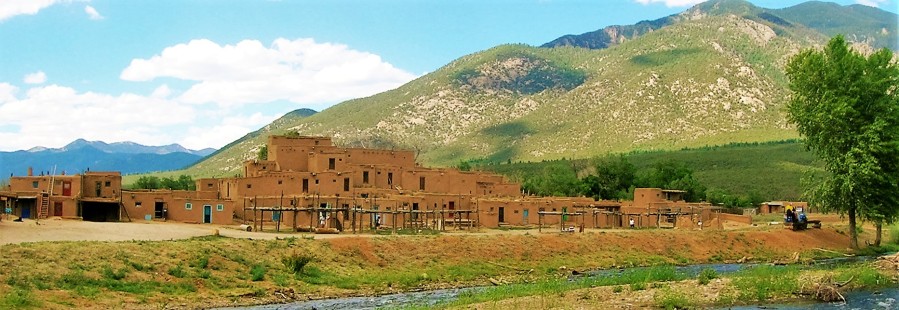
The Taos and Acoma pueblos are considered to be the longest occupied places in the United States. People have been living in these villages for 1000 years or more. Christianity arrived with the Spanish about 400 years ago. Most, if not all, of New Mexico’s Indian Pueblos have mission churches. Some have a history of conflict and violence. Ansel Adams made the Taos Pueblo church of San Geronimo de Taos (after St. Jerome) somewhat famous based on his photographs. Any visitor to the Taos Pueblo will see the San Geronimo mission church positioned between the two large pueblo housing blocks
A mission church was established at Taos Pueblo as early as 1620s but was not well received and was a source of conflict. That church was destroyed following the Pueblo Revolt of 1680. A second mission church was built around 1726. The current church was constructed in 1850 following the destruction of the second church in a battle between American soldiers and Mexican and Indian defenders during the Mexican-American War. The church we see today is changed somewhat from its original design due to the addition of the two towers and other modifications but it fits in the Spanish colonial style.
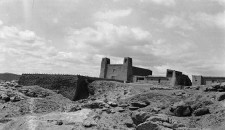 At Acoma Pueblo, west of Albuquerque, the mission church of San Estevan del Rey is a massive adobe structure perched on the mesa top in the pueblo village. The church is the largest adobe structure in the United States. The Coronado expedition of 1540 took note of the Acoma pueblo and Christianity arrived when the first Spanish Governor arrived in 1598 to impose Spanish control and establish settlements. This was not a peaceful transition and a mission church was not established at Acoma until 1629 – built with the forced labor of the Indians under the direction of the Franciscans. The Spanish were driven out during the 1680 Pueblo revolt and Acoma retained its independence until 1699 when the Spanish regained control over the pueblo. The mission church survived the revolt relatively unscathed and mission life soon returned to the community.
At Acoma Pueblo, west of Albuquerque, the mission church of San Estevan del Rey is a massive adobe structure perched on the mesa top in the pueblo village. The church is the largest adobe structure in the United States. The Coronado expedition of 1540 took note of the Acoma pueblo and Christianity arrived when the first Spanish Governor arrived in 1598 to impose Spanish control and establish settlements. This was not a peaceful transition and a mission church was not established at Acoma until 1629 – built with the forced labor of the Indians under the direction of the Franciscans. The Spanish were driven out during the 1680 Pueblo revolt and Acoma retained its independence until 1699 when the Spanish regained control over the pueblo. The mission church survived the revolt relatively unscathed and mission life soon returned to the community.
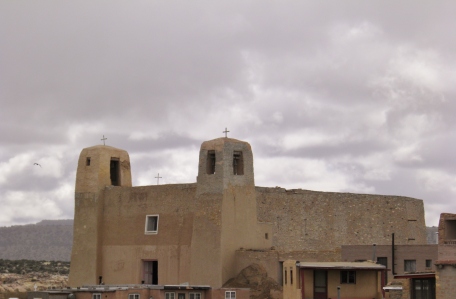
The church we see today is the original structure dating to 1629. It was extensively restored in the 1930s and is now maintained by a special society of Acoma residents who dedicate their life to maintaining the mission. The mission bell was a gift from King Charles of Spain. Portions of the structure are constructed with a mix of stone and adobe.
The interior is largely unadorned except for wall paintings and the altarpiece and religious paintings. The church still has its dirt floor. The church cemetery is in front of the building in a flat area that has been built up with burials over the last four centuries.

Chimayó
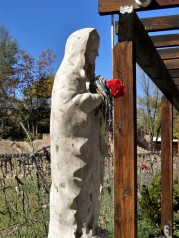 The town of Chimayó is also on the High Road to Taos and is famous for its pilgrimage site, El Santuario de Chimayó, officially named El Santuario de Nuestro Señor de Esquipulas. This church originated as a family chapel belonging to the Abeyta family, a fairly common practice of the region. The origin is shrouded in mystery and legend but it is revered as a site of miracles due to the healing properties of the “Holy dirt” found in a side room of the church. In general, Don Bernardo Abeyta, a member of Los Penitentes, a lay religious brotherhood, had a religious experience on the site and was healed by the dirt. He constructed a small chapel for people to come for healing and replaced it in 1816 with the current larger church structure. The church remained in the family until 1929 when it became part of the Archdiocese of Santa Fe. About 300,000 pilgrims come to the site each year with 30,000 coming during Holy Week.
The town of Chimayó is also on the High Road to Taos and is famous for its pilgrimage site, El Santuario de Chimayó, officially named El Santuario de Nuestro Señor de Esquipulas. This church originated as a family chapel belonging to the Abeyta family, a fairly common practice of the region. The origin is shrouded in mystery and legend but it is revered as a site of miracles due to the healing properties of the “Holy dirt” found in a side room of the church. In general, Don Bernardo Abeyta, a member of Los Penitentes, a lay religious brotherhood, had a religious experience on the site and was healed by the dirt. He constructed a small chapel for people to come for healing and replaced it in 1816 with the current larger church structure. The church remained in the family until 1929 when it became part of the Archdiocese of Santa Fe. About 300,000 pilgrims come to the site each year with 30,000 coming during Holy Week.
At first glance the Santuario looks somewhat different from the other parish churches and missions. It has a peaked roof rather than a more common flat roof and there is more exposed wood, either for structural purposes or for decoration.
The interior largely conforms to the layout of other churches with religious art and multiple carved and painted altarpieces. The grounds have been substantially changed to accommodate the large number of pilgrims. There is an outdoor area for performing large masses because the church nave will not accommodate anywhere close to the number. A side room inside the church contains crutches and other medical aids that were left behind by pilgrims seeking a cure or healing from some sort of physical affliction.
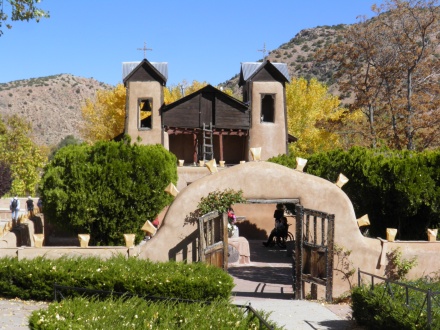
Chimayó has a second interesting chapel, the Oratorio de San Buenaventura. This is a very small family chapel built as part of the old defensive plaza, Plaza del Cerro (1749). Plaza del Cerro is the last remaining fortified plaza in New Mexico and, though seriously is in need of some restorative attention, it is still occupied as family residences.
The Oratorio makes up one of the attached structures forming what was a defensive wall around the plaza. It appears to be a simple vernacular adobe structure from the outside except that there is a small wooden belfry or steeple perched on the roof.
The interior is plain with a small altar and some religious art. The dirt floor is probably similar to what most of the early churches were like and the ceiling is made of rough vigas and planks. A primitive wooden candle chandelier and a single window provide light. There are family burials in the floor of the chapel.
Pecos and the other missions
Several old Spanish mission churches exist only as ruins. Most of these, as at the Jemez Mission and the Salt Missions southeast of Albuquerque, are not adobe but are constructed of stone which was abundant in the area and possibly less work than constructing thousands of adobe bricks. These missions were established early but were mostly abandoned around the time of the Pueblo Revolt (1680) or due to declining populations and attacks from Plains Indian raiders.
The exception is Pecos Mission, a short distance southeast of Santa Fe. Pecos Mission was made of adobe and has been melting away on its hilltop site for almost 200 years. The pueblo, originally names Cicuye, was on the eastern fringe of pueblo communities and an important trade center with the plains tribes. The Spanish arrived and the Franciscans built a large mission church in the 1620s, of course with coerced Indian labor. The relations with the local people deteriorated over the decades and finally the priest was killed and the mission church destroyed during the Pueblo Revolt.
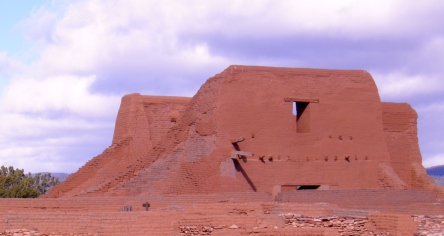
A new smaller mission church was constructed after the Spanish returned and, with better community relations, the church functioned for several generations. By the time of the opening of the Santa Fe Trail the Pecos pueblo was seriously depopulated. Loss of trading partners, disease and dwindling population led to the eventual abandonment of the pueblo in the 1830s and the mission church fell into ruin. This second church is what is visible today although the massive original church foundation can still be seen. Today the church and adjoining pueblo site is preserved by the National Park Service.
If this was the smaller of the two Pecos mission churches you can imagine how large the original structure must have been.
As I mentioned, there are probably dozens more of these adobe churches beyond what I’ve shown here. I know of a couple others within 10 or 15 miles of my house. The mission church at Isleta Pueblo (San Agustin de la Isletas – 1629) was recently restored. There is also a small adobe church (San Ysidro – 1868) maintained by the historical society in Corrales.
* * *








































Reblogged this on Writer's Cramp.
LikeLike
I enjoyed this very much. My husband and I just returned from a trip to Northern New Mexico and saw some of the churches you described. I am also preparing a post about the same topic.
LikeLike
I’m glad you enjoyed New Mexico…and the blog.
LikeLiked by 1 person
[…] I haven’t visited. This is part two of a (probable) longer series. The first installment is here. This one highlighted three old churches that fell into disrepair but were rescued by a community […]
LikeLike